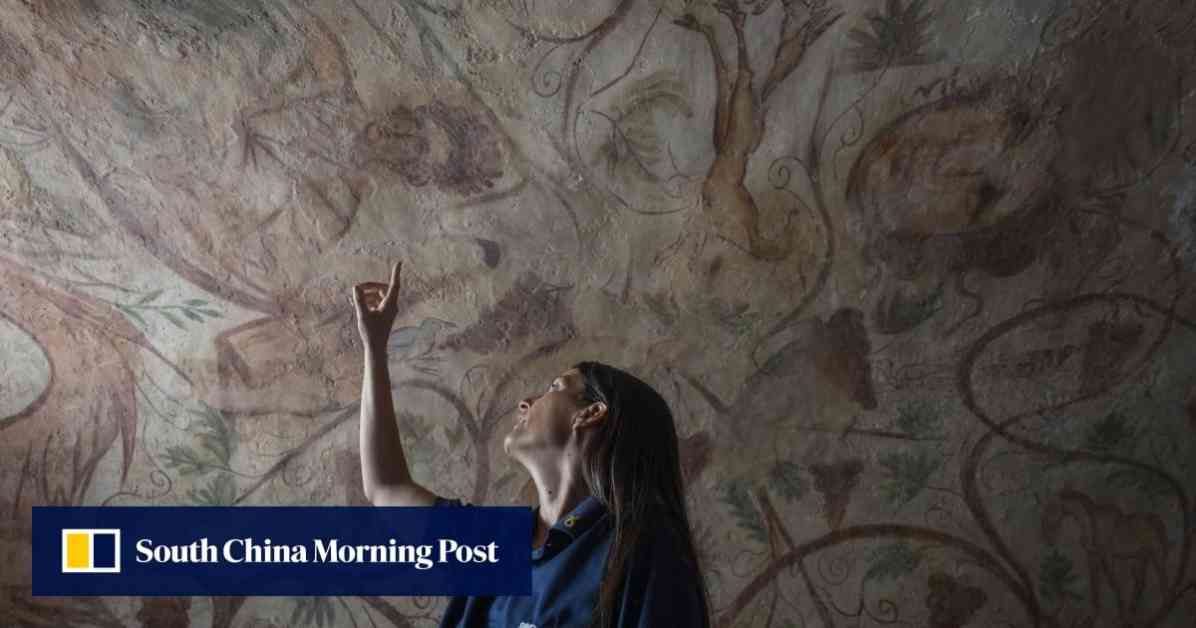Uncovering Ancient Roman-Era Tombs in Israel: A Fascinating Journey Through History
The Israel Antiquities Authority recently made an exciting announcement that is sure to captivate history enthusiasts and archaeology buffs alike. Two Roman-era tombs, adorned with intricate murals depicting mythological figures, will soon be open to the public for exploration. These tombs, which date back over 1,600 years, offer a rare glimpse into the past and provide invaluable insights into the lives and beliefs of ancient civilizations.
Located near the port of Ashkelon, a picturesque southern city in Israel, these tombs were discovered over half a century apart. The first tomb, dating back to the 4th century, was initially uncovered by a British expedition in the 1930s. Upon entering the tomb, visitors will be greeted by stunning depictions of nymphs wearing lotus flower crowns, children playing the flute, and various birds and animals. The intricate details and vibrant colors of the murals are a testament to the skill and artistry of the ancient craftsmen who created them.
The second tomb, dating from the second century, served as the final resting place for several generations of an aristocratic family. Discovered in the 1990s by Israeli archaeologist Elena Kogan-Zehavi, this tomb offers a unique window into the social structure and customs of the time. Kogan-Zehavi described her surprise upon entering the tomb as a young archaeologist, noting that it was initially covered in debris and rubbish. Despite the challenges, she persevered and uncovered a treasure trove of historical artifacts that shed light on the lives of the elite in ancient Roman society.
Preserving History: The Importance of Archaeological Conservation
The preservation of ancient tombs and artifacts is a crucial aspect of archaeological research and cultural heritage conservation. The Israel Antiquities Authority, along with dedicated archaeologists like Elena Kogan-Zehavi, plays a vital role in safeguarding these sites for future generations. By opening these tombs to the public, the Authority aims to promote awareness and appreciation of Israel’s rich history and archaeological legacy.
Elena Kogan-Zehavi emphasized the significance of the painted tombs in Ashkelon, noting that only eight such tombs have been discovered in Israel thus far. Out of these, the two tombs in Ashkelon are the only ones accessible to the public, making them a truly special and unique attraction. Visitors will have the opportunity to immerse themselves in the ancient world, marveling at the artistry and symbolism depicted in the murals that adorn the tomb walls.
Ashkelon, with its more than 3,000 years of history, was a prominent city during Roman times, serving as a hub of trade and culture in the region. The city’s mayor, Tomar Glam, expressed pride in the city’s heritage and the efforts to preserve its glorious past. By opening these ancient tombs to the public, Ashkelon is ensuring that its history remains alive and accessible to all who wish to explore and learn from it.
Unraveling the Mysteries of the Past: A Journey Through Ancient Roman Art and Culture
As visitors step into the ancient Roman-era tombs in Ashkelon, they are transported back in time to a world of myth and legend. The murals that adorn the walls of these tombs offer a visual narrative of the beliefs and values of the people who lived and died there centuries ago. From depictions of mythical creatures to scenes of everyday life, the murals provide a glimpse into the rich tapestry of Roman art and culture.
Archaeologist Elena Kogan-Zehavi, who has dedicated her career to studying and preserving ancient artifacts, highlighted the importance of these tombs in understanding the social and religious practices of the time. The murals, she explained, were not merely decorative but served a symbolic and ritualistic purpose, guiding the deceased on their journey to the afterlife. By studying these murals, archaeologists can piece together the beliefs and customs of ancient Roman society, shedding light on a world long gone but not forgotten.
For history buffs and enthusiasts of ancient civilizations, a visit to the Roman-era tombs in Ashkelon is an unparalleled experience. Walking among the ancient walls and gazing upon the intricate frescoes, one can’t help but feel a sense of awe and wonder at the craftsmanship and artistry of the past. Each detail tells a story, each figure a character in the drama of history, inviting visitors to delve deeper into the mysteries of the past and unravel the secrets hidden within these ancient tombs.
In conclusion, the opening of the Roman-era tombs in Ashkelon is a momentous occasion that offers a unique opportunity to explore the ancient world and connect with the lives of those who came before us. Through the preservation and study of these tombs, we can gain a deeper understanding of our shared human history and appreciate the beauty and complexity of ancient civilizations. As we walk in the footsteps of our ancestors, we are reminded of the enduring legacy of the past and the importance of preserving it for future generations.



















